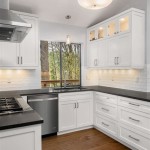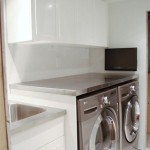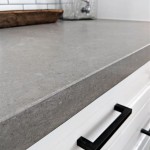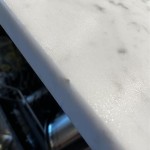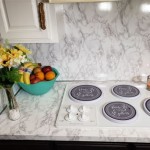Make Your Own Kitchen Countertops: A Comprehensive Guide
Kitchen countertops are a significant design element, impacting both the aesthetic appeal and functional utility of a kitchen space. While professionally installed countertops offer convenience, the associated costs can be substantial. Constructing countertops oneself presents a viable alternative, offering cost savings and customization opportunities. However, a successful outcome necessitates careful planning, material selection, and diligent execution.
This article provides a comprehensive guide to crafting kitchen countertops, outlining key considerations and practical steps. The information presented is intended to equip individuals with the knowledge necessary to make informed decisions and execute a countertop construction project effectively. This process is not necessarily simple and requires a degree of skill and precision in woodworking and construction.
Planning and Design Considerations
The initial phase of countertop construction involves meticulous planning and design. This encompasses determining the dimensions, layout, and material choices, all of which directly influence the project's overall success. Accurate measurements are paramount; inaccuracies at this stage can lead to significant problems later in the construction process. It is crucial to measure the existing cabinetry meticulously, accounting for any potential irregularities or uneven surfaces. Consider using laser measuring tools to ensure accuracy across longer spans.
Layout considerations extend beyond simple linear measurements. The placement of sinks, cooktops, and other built-in appliances must be factored into the design. Templates can be used to accurately mark the cutouts required for these fixtures. Sufficient overhang beyond the cabinet edges is also necessary to prevent spills from dripping directly onto cabinet doors. A typical overhang ranges from one to one and a half inches. Furthermore, the overall aesthetic should align with the existing kitchen design. Consider the color scheme, style, and surrounding materials to ensure a cohesive and harmonious result. The thickness of the chosen countertop material will also affect the overall look and feel. Thicker countertops often convey a sense of luxury and durability, but they may also impact cabinet door clearance.
Beyond general layout, structural support is a critical component. Long countertop spans might require additional bracing or support structures to prevent sagging or bowing over time. This is particularly true for heavier materials like concrete or thick slabs of wood. Consult with a structural engineer or experienced contractor if unsure about the necessary support requirements. The edges of the countertop also warrant careful consideration. Various edge treatments are available, ranging from simple rounded edges to more elaborate profiles. The chosen edge treatment can significantly impact the countertop's appearance and functionality. Consider the ease of cleaning and maintenance when selecting an edge profile.
Material Selection
The choice of countertop material is a crucial decision, influencing both the aesthetics and the longevity of the finished product. Several materials are suitable for DIY countertop construction, each possessing its own unique advantages and disadvantages. Common options include wood (butcher block), concrete, tile, and laminate. Selecting the appropriate material depends on factors such as budget, aesthetic preferences, durability requirements, and ease of workability.
Wood, particularly butcher block, offers a warm and inviting aesthetic. It is relatively easy to work with using standard woodworking tools. However, wood is susceptible to water damage and requires regular sealing and maintenance to prevent staining and warping. Different wood species offer varying levels of durability and resistance to moisture. Hardwoods like maple and oak are generally more durable than softwoods like pine. Consider the grain pattern and color of the wood to achieve the desired aesthetic.
Concrete countertops can provide a modern and industrial aesthetic. They are highly durable and heat-resistant but are also heavy and require specialized tools and techniques for fabrication. Working with concrete involves creating a mold, mixing and pouring the concrete, and allowing it to cure properly. The curing process is critical to achieve maximum strength and durability. Concrete countertops can be stained and sealed to achieve a variety of colors and finishes. However, concrete is porous and requires regular sealing to prevent staining and absorption of liquids.
Tile countertops offer a wide range of design possibilities and are relatively inexpensive. However, the grout lines between tiles can be difficult to clean and maintain. Selecting the right type of tile is crucial; porcelain or ceramic tiles are generally the best choice for countertops due to their durability and water resistance. The installation process involves setting the tiles on a cement board substrate and then grouting the joints. Proper sealing of the grout is essential to prevent staining and mold growth.
Laminate countertops are a cost-effective option that offers a wide variety of colors and patterns. They are relatively easy to install but are less durable than other materials. Laminates are susceptible to scratches and heat damage. Installation involves adhering the laminate to a particleboard or MDF substrate. The edges of the laminate can be finished with matching edge banding. While affordable, laminate countertops typically have a shorter lifespan than other materials.
Regardless of the material chosen, it is essential to source high-quality materials from reputable suppliers. Investing in quality materials will contribute to the longevity and overall satisfaction with the finished countertop.
Construction Process
The actual construction process varies depending on the chosen material. However, certain fundamental steps apply across most countertop projects. These include preparing the substrate, cutting and shaping the material, assembling the pieces, and applying a finish. Safety precautions are paramount throughout the construction process. Wear appropriate safety gear, including eye protection, ear protection, and gloves.
Preparing the substrate is crucial for ensuring a stable and level surface for the countertop. This typically involves attaching a layer of plywood or MDF to the existing cabinetry. Ensure that the substrate is securely fastened to the cabinets and that it is perfectly level. Any irregularities in the substrate will be reflected in the finished countertop.
Cutting and shaping the material requires precision and attention to detail. Use appropriate cutting tools for the chosen material. For wood, a circular saw or table saw is often used. For concrete, a wet saw is used. Follow the manufacturer's instructions for using the cutting tools safely and effectively. Cut the material slightly larger than the final dimensions and then trim it to the exact size using a router or sander.
Assembling the countertop pieces involves joining them together securely. For wood countertops, this can be accomplished using wood glue and screws. For concrete countertops, the pieces can be joined using epoxy or a specialized concrete adhesive. Ensure that the joints are tight and seamless. Use clamps to hold the pieces together while the adhesive dries.
Applying a finish is essential to protect the countertop from damage and enhance its appearance. For wood countertops, a sealant or varnish is typically used. For concrete countertops, a sealer is used to prevent staining. For tile countertops, the grout is sealed to prevent water absorption. Follow the manufacturer's instructions for applying the finish. Apply multiple coats of finish for added protection. Allow the finish to dry completely before using the countertop.
Finally, installing the sink and faucet requires careful planning and execution. Follow the manufacturer's instructions for installing these fixtures. Ensure that the sink and faucet are properly sealed to prevent leaks. Test the plumbing thoroughly before using the countertop. Correct any leaks or problems before completing the installation.
Throughout the entire construction process, accuracy and attention to detail are paramount. Take your time and double-check your measurements before making any cuts. A well-constructed countertop will not only enhance the appearance of the kitchen but also provide years of reliable service.

How To Build Countertops Simple Step By Guide

Affordable Diy Countertops That Will Blow Your Mind

How To Make Your Own Faux Marble Countertops From Plywood And Save Thousands

House Renovation How To Make Your Own Wooden Worktop Youtube

How To Make Your Own Wood Countertops Diy Pantry Idea Youtube

Diy Concrete Kitchen Countertops

How To Install A Granite Kitchen Countertop

Diy Concrete Countertops Home With Stefani

90 Modern Kitchen Island Ideas To Transform Your Home In 2025

How To Install Laminate Countertops The Home
See Also

